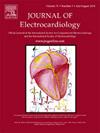A simple electrocardiographic model for an improved detection of chronic thromboembolic pulmonary hypertension after pulmonary embolism
IF 1.2
4区 医学
Q3 CARDIAC & CARDIOVASCULAR SYSTEMS
引用次数: 0
Abstract
Introduction
Chronic thromboembolic pulmonary hypertension (CTEPH) is considered a late sequelae of a preceding pulmonary embolism (PE). There is reasonable suspicion that the majority of CTEPH patients are currently not detected. The aim of the present study was to evaluate the potential utility of a simple electrocardiographic (ECG) model for an improved detection of CTEPH after PE.
Material and methods
The present study was conducted as a bicentric, retrospective cross-sectional study in two German high volume referral centres for pulmonary hypertension (PH) between February 2011 and September 2023. A total of 100 patients with CTEPH and 100 patients with excluded PH were included. An ECG model for detecting CTEPH consisting of a screening test and confirmatory test was developed and subsequently tested on the present CTEPH cohort and a hypothetical cohort of PE survivors from Germany.
Results
Applying this ECG model to the present CTEPH cohort, 79 % of CTEPH patients were correctly identified (sensitivity: 79 %) and only 8 % of non-PH patients were incorrectly identified as PH patients (specificity: 92 %). When theoretically applying this model in CTEPH screening of a hypothetical cohort of persistently symptomatic PE survivors, a total 70 % of CTEPH patients could potentially be detected (sensitivity: 70 %) and right heart catheterisations (RHC) without pathological findings would only be performed on 2.5 % of non-CTEPH patients (specificity: 97.5 %) without the application of echocardiography. Compared to the current estimated CTEPH detection rate this would be about a threefold increase (from 24 % to 70 %).
Conclusion
Electrocardiographic CTEPH screening could potentially increase the CTEPH detection rate significantly, without the application of echocardiography and with performance of only very few RHCs without pathological findings, if all persistently symptomatic PE survivors were given a simple ECG as standard follow-up. However, the present approach remains largely hypothetical for now and must be validated externally.
肺动脉栓塞后慢性血栓栓塞性肺动脉高压的改进检测的简单心电图模型
慢性血栓栓塞性肺动脉高压(CTEPH)被认为是先前肺栓塞(PE)的晚期后遗症。有理由怀疑大多数CTEPH患者目前未被发现。本研究的目的是评估一种简单的心电图(ECG)模型对PE后CTEPH检测的潜在效用。材料和方法本研究是2011年2月至2023年9月在德国两家高容量肺动脉高压(PH)转诊中心进行的一项双中心、回顾性横断面研究。共纳入100例CTEPH患者和100例排除性PH患者。开发了一种检测CTEPH的ECG模型,包括筛查试验和确认试验,并随后在当前CTEPH队列和德国PE幸存者的假设队列中进行了测试。结果将该ECG模型应用于目前的CTEPH队列,79%的CTEPH患者被正确识别(敏感性:79%),只有8%的非PH患者被错误识别为PH患者(特异性:92%)。当理论上将该模型应用于持续有症状的PE幸存者的CTEPH筛查时,总共有70%的CTEPH患者可能被检测到(敏感性:70%),而没有病理发现的右心导管(RHC)只能在2.5%的非CTEPH患者(特异性:97.5%)不应用超声心动图进行。与目前估计的CTEPH检出率相比,这将增加约三倍(从24%增加到70%)。结论心电图CTEPH筛查可显著提高CTEPH检出率,无需超声心动图,只有极少数rhc表现无病理发现,如果所有持续症状的PE幸存者都给予简单的心电图作为标准随访。然而,目前的方法在很大程度上仍然是假设的,必须从外部验证。
本文章由计算机程序翻译,如有差异,请以英文原文为准。
求助全文
约1分钟内获得全文
求助全文
来源期刊

Journal of electrocardiology
医学-心血管系统
CiteScore
2.70
自引率
7.70%
发文量
152
审稿时长
38 days
期刊介绍:
The Journal of Electrocardiology is devoted exclusively to clinical and experimental studies of the electrical activities of the heart. It seeks to contribute significantly to the accuracy of diagnosis and prognosis and the effective treatment, prevention, or delay of heart disease. Editorial contents include electrocardiography, vectorcardiography, arrhythmias, membrane action potential, cardiac pacing, monitoring defibrillation, instrumentation, drug effects, and computer applications.
 求助内容:
求助内容: 应助结果提醒方式:
应助结果提醒方式:


